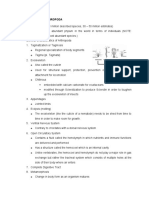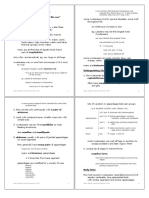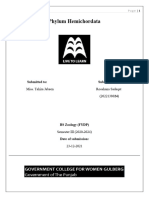0 ratings0% found this document useful (0 votes)
13 viewsLecture 6
Uploaded by
hndmad390Copyright
© © All Rights Reserved
Available Formats
Download as PDF or read online on Scribd
0 ratings0% found this document useful (0 votes)
13 viewsLecture 6
Uploaded by
hndmad390Copyright
© © All Rights Reserved
Available Formats
Download as PDF or read online on Scribd
You are on page 1/ 18
Lecture (6)
Phylum Arthropoda, Contd.
ense organs
1.The Compound Eye:
O21 It is composed of a large number of vertically arranged
Q
°
visual units (the ommatidia) .
The surface area of each ommatidium is covered by a
portion of transparent cuticle corneal facet).
Ommatidium is composed of :
> The corneal lens is secreted by the underlying two
corneagen cells.
> The crystalline cone is a long transparent refractive
body. It is secreted by four long crystalline cells and
surrounded by long pigment cells.
> The retina is formed of eight pigmented sensory
retinula cells, arranged around an inner refractive
rod called the rhabdome .
> The inner ends of the retinula cells penetrate the
basement membrane in the form of a nerve bundle
which pass into the optic nerve.
Pigment cells form a complete thin cylinder around
the ommatidium
> When light is strong , the proximal and distal
pigments spread all over and act as a screen
preventing light from crossing from one ommatidium
to another and vice versa.
yay
corneagen cells
det
crystalline cells
tee WE
pigment cells
iol
thabdome
ashe ye
revinula cells
teas Sit
nerve fibres
paid
corneal lens
Sat yA
enptalline cone
baat
stomach
2-Statocyst
Q There is a pair of statocysts situated in the proximal segment of the 1 antenna.
Q Each statocyst develops as an ectodermal invagination in the form of a small}
vesicle with a narrow aperture which partly sealed by dense setae.
Q Sensory hairs project from special receptor cells in the wall of the statocyst]
towards its cavity.
Q This cavity is filled with a_gelatinous fluid in which are embedded a number of
fine sand grains, statoliths, arranged in contact with the sensory hairs in a special
order.
Q Any vibration in the surrounding water transports its effect to the sand grains,
which will be felt by the sensory hairs of the statocysts.
Apap) Jai WS
Ciliated receptor cells
dye gil
Cilia
aisclpas
js) Aaya a
sensing gravity & igen ipa AS
Sensory nerve fibers
3- Chemoreceptors
Q These are sensory hairs that concerned with smell
(borne on the two pairs of antennae) and taste( on the
feeding appendages)
4-Tactile hairs:
Q These are mainly concentrated on the feeler of 2"¢
antennae (for orientation) and on oral appendages and
chelipeds(for feeding)
Life cycle:
OFertilization externally occurs, where the seminal fluids
deposited by the male in the thelycum that serves as an
external seminal receptacle in the female.
OFertilized ova are then shed directly into the sea.
OThe fertilized egg hatch out early in a simple free-swimming
larva known as the Nauplius larva which moults and passes
through three successive larval stages : protozoaea , zoaea
and mysis larvae.
OTherefore, development of the prawn involves a process of
complete metamorphosis.
Life cycle:
- Fertilized egg > hatchs > Nauplius larva > moults >
Portozoaea larva > moults > Zoaea larva > moults > Mysis
larva > moults > Adult °
Phylum: Arthropoda
Subphylum II: Crustacea
Class 1: Malacostraca
Order (1): Decapoda
Suborder (B): Pleocyemata (reptantia)
Crustacean decapods are adapted for crawling, although some have
become secondarily adapted for swimming. They are characterized by
the following:
~The body is dorsoventrally flattened, the rostrum is reduced or
absent.
“The ambulatory appendages (pereiopods) are usually heavier than
those of the dendrobranchiata and the first pair of legs is usually
powerful chelipeds.
~The abdominal appendages (Pleopods 1-5) are often reduced and
are never modified for swimming.
~The abdomen exhibits various degrees of reduction.
1 The Pleocymata is further divided into the following infraorders:
Macrura , Brachyura and Anomura.
Phylum: Arthropoda
Subphylum II: Crustacea
Class 1: Malacostraca
Order (1): Decapoda
Suborder (B): Pleocyemata
Infraorder 1: Macrura
(large-tailed)
Family: Astacidae
Ex.: Astacus fluviatilis
(crayfish)
Abdomen is extended and well-
developed , bearing full number
of appendages
General Characteristics:
» Habitat: fresh water
& Body shape: It is much broader and shorter than prawn
» Cephalothorax: is covered by a large carapace with reduced
rostrum
» The abdomen: is markedly dorsoventrally flattened, extended
and well developed with full number of small appendages
» The Cephalic appendages:
+ Two pairs of antennae in addition to three pairs of oral
appendages.
» The thoracic appendages:
* Three pairs of small, leg-like maxillipeds.
» Five pairs of ambulatory appendages:
The 1* pair is markedly large cheliped, terminating in huge
chelae for fighting and seizing
“+ The remaining four pairs are markedly smaller, long and
slender walking legs of which the anterior two pairs are
chelate.
» The abdominal appendages: are reduced in size, except for the
uropod which is larger and much broader
Phylum: Arthropoda
Subphylum: Crustacea
Class1: Malacostraca
Order (1): Decapoda
Suborder (B): Pleocyemata
Infraorder 2: Brachyura (short- tailed)
Family: Portunidae
Ex.: Neptunus plagicus (crab)
Ea tall By
AA ey
7 _L chetiped Sth thoracic appendage
BE 2 eS Pr
o oN
i i, SE Hat ah Y
Git tennate S ath ne i
Ww antenna, cephalothorax ‘4 N
\ Boo 7 Vi j
of pier 9 gy
Ss aS
SS es 2 Z
carapace ope (Dorsal view rs oS ,
Gah pall Sat
- os Sth thoracic
> & « ne dys » Ub SI ed) poner
General Characteristics:
>> Habitat: aquatic
> Body regions:
‘+ A broad cephalothorax and greatly reduced flexed abdomen
> The cephalothorax: is wider than long.
* It is compressed and covered by a large horizontal carapace
produced laterally into hollow expansions (branchiostegites)
covering the gills
> The cephalic appendages
* comprises two pairs of antennae, and three pairs of oral
appendages( mandible, 1** & 2" maxillae), in addition to a pair of
stalked compound eye
> The thoracic appendages comprises:
Three pairs of maxillipeds, the third ones are flattened, covering
all the appendages in front
> Five pairs of uniramous appendages:
% The 1* pair is well developed chelipeds with powerful chelae (for
fighting& seizing)
* The following 3 pairs are walking legs ( for moving sidewise)
% The last pair has flattened segments and act as swimming paddles
The abdomen is greatly reduced , lacking uropod and tightly flexed
beneath the cephalothorax °
The abdominal segments are commonly fused, bearing reduced
appendages which are few in number.
In the female: the abdomen is broad, consisting of 6 segments and
carries 4 pairs of biramous appendages( on segments 2-5)
> In the male: the abdomen is narrow and triangular , consisting of
4 segments, the first two of which carry long slender uniramous
J appendages
WU ASE Joh
Sra maxiliped
le of crab ‘ola :
1. The first larval stage (Zoaea larva) is similar to that of prawn but with a
median dorsal spine
2. The second larval stage (Megalopa larva) with a crab-ike cephalothorax
carrying similar appendages and a long unflexed abdomen bearing normal
swimmerets
a) oe
= ee . wn
SS et ots
cheliped antenna
ett RS
cphtterat AS ed K gies
ie mvp Dorsal pine
1 Joh ¢
tne 2 AS) Jo Bh ai
j inlet
haut hh
oe en Sea
abdomen sopendegeh
SH
= roped
Arse sine Bl
Megalopa larva of Neprunus ea Ly 5 20
Zonea larva tat
Phylum: Arthropoda
Subphylum II: Crustacea
Class 1: Malacostraca
Order: Decapoda
Suborder (B): Pleocyemata
Infraorder (3): Anomura
Family: Paguridae
EX. Pagurus Tinctor (Hermit crab)
General Characteristics:
> Habitat: the sea coast, inside empty gastropod shells
> Body regions: *
UU Cephalothorax is covered by a reduced carapace,
© It bears pairs of appendages similar to those of crab except the following:
* the 4% thoracic ones (chelipeds) are asymmetrical, where the left huge ch
close the opening of the shell
* the last 2 pairs of thoracic appendages are small and chelate
O The abdomen:
* The non segmented abdomen is fleshy and twisted so as to fit inside the shell.
‘The abdominal appendages are reduced and totally absent on the right side,
“© The last pair is hook-like vyhich attaches firmly to the columella of the shell.
serves to
AS Set
onteed AABN Sy pk Satish
ia chetaad wean
tat St eee?
eae ete pl
soci ech eneeaae tegemtngs
Lan ag says
joka Cfgh —— sn soso appendage
7 aan oe hey
7
ragerks ALL lb It
PAGURUS TINCTOR
You might also like
- Protostomate Eucoelomates: Exercise 7 Part 3No ratings yetProtostomate Eucoelomates: Exercise 7 Part 324 pages
- Phylum Athropoda, Chordata, EchinodermataNo ratings yetPhylum Athropoda, Chordata, Echinodermata14 pages
- Lecture 7 - Intro. To Arthropods Moulting Crustaceans ChelicerataNo ratings yetLecture 7 - Intro. To Arthropods Moulting Crustaceans Chelicerata81 pages
- Protochordates and The Origin of The Chordates: Deuterostomes Phylum EchinodermataNo ratings yetProtochordates and The Origin of The Chordates: Deuterostomes Phylum Echinodermata7 pages
- General Zoology Module 1 Arthropoda and EchinodermataNo ratings yetGeneral Zoology Module 1 Arthropoda and Echinodermata5 pages
- Animalia & Kingdom by Sir Adeeb Rattar-2No ratings yetAnimalia & Kingdom by Sir Adeeb Rattar-25 pages
- Mollusca, Echinodermata, Hemichordata, ChordataNo ratings yetMollusca, Echinodermata, Hemichordata, Chordata65 pages
- Planaria Fasciola Teania Solium: Phylum: PlatyhelminthesNo ratings yetPlanaria Fasciola Teania Solium: Phylum: Platyhelminthes18 pages
- Crustaceans: Distinguishing Characteristics of CrustaceaNo ratings yetCrustaceans: Distinguishing Characteristics of Crustacea11 pages
- Mollusca (Mollusks) Definition: Molluscs (Also Know As Mollusks) Are Soft-Bodied, Bilaterally Symmetrical, SegmentedNo ratings yetMollusca (Mollusks) Definition: Molluscs (Also Know As Mollusks) Are Soft-Bodied, Bilaterally Symmetrical, Segmented12 pages
- BIOL-3426 - Lab 7 - Subfilos Chelicerata y Crustacea-2022 PDFNo ratings yetBIOL-3426 - Lab 7 - Subfilos Chelicerata y Crustacea-2022 PDF25 pages
- Echinodermata Classification N CharactersNo ratings yetEchinodermata Classification N Characters34 pages
- Lecture 7 - Intro. To Arthropods Moulting Crustaceans ChelicerataLecture 7 - Intro. To Arthropods Moulting Crustaceans Chelicerata
- Protochordates and The Origin of The Chordates: Deuterostomes Phylum EchinodermataProtochordates and The Origin of The Chordates: Deuterostomes Phylum Echinodermata
- General Zoology Module 1 Arthropoda and EchinodermataGeneral Zoology Module 1 Arthropoda and Echinodermata
- Planaria Fasciola Teania Solium: Phylum: PlatyhelminthesPlanaria Fasciola Teania Solium: Phylum: Platyhelminthes
- Crustaceans: Distinguishing Characteristics of CrustaceaCrustaceans: Distinguishing Characteristics of Crustacea
- Mollusca (Mollusks) Definition: Molluscs (Also Know As Mollusks) Are Soft-Bodied, Bilaterally Symmetrical, SegmentedMollusca (Mollusks) Definition: Molluscs (Also Know As Mollusks) Are Soft-Bodied, Bilaterally Symmetrical, Segmented
- BIOL-3426 - Lab 7 - Subfilos Chelicerata y Crustacea-2022 PDFBIOL-3426 - Lab 7 - Subfilos Chelicerata y Crustacea-2022 PDF





























































